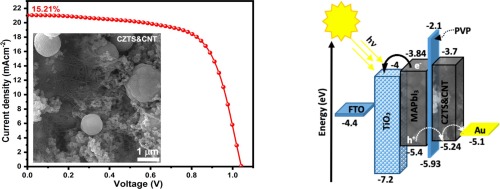当前位置:
X-MOL 学术
›
Sol. Energy
›
论文详情
Our official English website, www.x-mol.net, welcomes your feedback! (Note: you will need to create a separate account there.)
Enhanced photovoltaic performance and stability of perovskite solar cells by interface engineering with poly(4-vinylpyridine) and Cu2ZnSnS4&CNT
Solar Energy ( IF 6.7 ) Pub Date : 2020-05-01 , DOI: 10.1016/j.solener.2020.03.093 Z. Shadrokh , Sh. Sousani , S. Gholipour , Y. Abdi
Solar Energy ( IF 6.7 ) Pub Date : 2020-05-01 , DOI: 10.1016/j.solener.2020.03.093 Z. Shadrokh , Sh. Sousani , S. Gholipour , Y. Abdi

|
Abstract Organic-inorganic perovskite solar cells (PSCs) are emerging candidates for next generation photovoltaic devices. In the last decade, PSCs have depicted a rapid development in device performance, meanwhile, the issue of utilizing low-cost, non-toxic materials with chemical stability as well as long term device stabilities are still lacking. To address these issues, an inexpensive, eco-friendly, and environmentally stable nanostructure of the quaternary chalcogenide Cu2ZnSnS4 (CZTS) as an inorganic hole transport material (HTM) has been investigated. Moreover, simultaneously two strategies has been employed to optimize the photovoltaic parameters. First, an interlayer of poly(4-vinylpyridine) (PVP) has been applied between the perovskite and the hole transport layer (HTL). Second, single-walled carbon nanotubes (CNTs) is incorporated into the CZTS HTL. While, the latter only result in higher short circuit current density (Jsc) from 18.3 to 20 mA cm−2, by using both of the strategies an increase in open circuit voltage (Voc) from 0.98 to 1.05 V as well as Jsc from 18.3 to 20.5 mA cm−2 has been observed. The power conversion efficiency (PCE) of the record device reached to 15.2%, fill factor (FF) increased up to 70% and also demonstrated low hysteresis of 2.3%. The formation of hydrophobic CNT webs among the sphere-like CZTS nanostructures and the presence of the PVP polymeric interlayer results in highly stable devices, which retained more than 98% of the initial PCE at room temperature and 40–45% humidity after 30 days. Thus, our results show that the combination of PVP interlayer and CZTS&CNT HTL offer an opportunity for the scalability of PSCs.
中文翻译:

通过与聚(4-乙烯基吡啶)和 Cu2ZnSnS4&CNT 的界面工程增强钙钛矿太阳能电池的光伏性能和稳定性
摘要 有机-无机钙钛矿太阳能电池 (PSC) 是下一代光伏器件的新兴候选者。在过去的十年中,PSC 描绘了器件性能的快速发展,同时,仍然缺乏利用具有化学稳定性和长期器件稳定性的低成本、无毒材料的问题。为了解决这些问题,已经研究了一种廉价、环保且环境稳定的四元硫属化物 Cu2ZnSnS4(CZTS)纳米结构作为无机空穴传输材料(HTM)。此外,同时采用两种策略来优化光伏参数。首先,在钙钛矿和空穴传输层(HTL)之间应用了聚(4-乙烯基吡啶)(PVP)夹层。第二,单壁碳纳米管 (CNT) 被纳入 CZTS HTL。而后者只会导致更高的短路电流密度 (Jsc) 从 18.3 到 20 mA cm-2,通过使用这两种策略,开路电压 (Voc) 从 0.98 增加到 1.05 V 以及 Jsc 从 18.3已观察到 20.5 mA cm-2。记录设备的功率转换效率 (PCE) 达到 15.2%,填充因子 (FF) 增加到 70%,并且还表现出 2.3% 的低滞后。在球状 CZTS 纳米结构之间形成疏水性 CNT 网,以及 PVP 聚合物夹层的存在导致器件高度稳定,在室温和 40-45% 的湿度下,器件在 30 天后保持超过 98% 的初始 PCE。因此,我们的结果表明,PVP 夹层和 CZTS&
更新日期:2020-05-01
中文翻译:

通过与聚(4-乙烯基吡啶)和 Cu2ZnSnS4&CNT 的界面工程增强钙钛矿太阳能电池的光伏性能和稳定性
摘要 有机-无机钙钛矿太阳能电池 (PSC) 是下一代光伏器件的新兴候选者。在过去的十年中,PSC 描绘了器件性能的快速发展,同时,仍然缺乏利用具有化学稳定性和长期器件稳定性的低成本、无毒材料的问题。为了解决这些问题,已经研究了一种廉价、环保且环境稳定的四元硫属化物 Cu2ZnSnS4(CZTS)纳米结构作为无机空穴传输材料(HTM)。此外,同时采用两种策略来优化光伏参数。首先,在钙钛矿和空穴传输层(HTL)之间应用了聚(4-乙烯基吡啶)(PVP)夹层。第二,单壁碳纳米管 (CNT) 被纳入 CZTS HTL。而后者只会导致更高的短路电流密度 (Jsc) 从 18.3 到 20 mA cm-2,通过使用这两种策略,开路电压 (Voc) 从 0.98 增加到 1.05 V 以及 Jsc 从 18.3已观察到 20.5 mA cm-2。记录设备的功率转换效率 (PCE) 达到 15.2%,填充因子 (FF) 增加到 70%,并且还表现出 2.3% 的低滞后。在球状 CZTS 纳米结构之间形成疏水性 CNT 网,以及 PVP 聚合物夹层的存在导致器件高度稳定,在室温和 40-45% 的湿度下,器件在 30 天后保持超过 98% 的初始 PCE。因此,我们的结果表明,PVP 夹层和 CZTS&


























 京公网安备 11010802027423号
京公网安备 11010802027423号